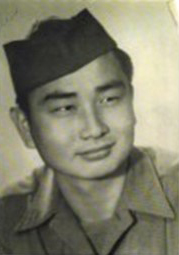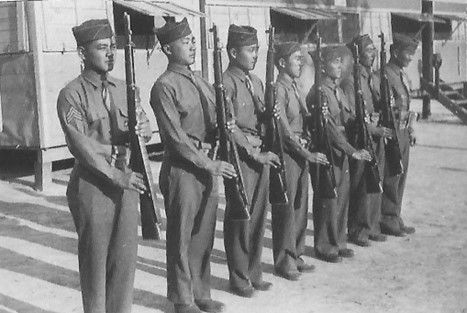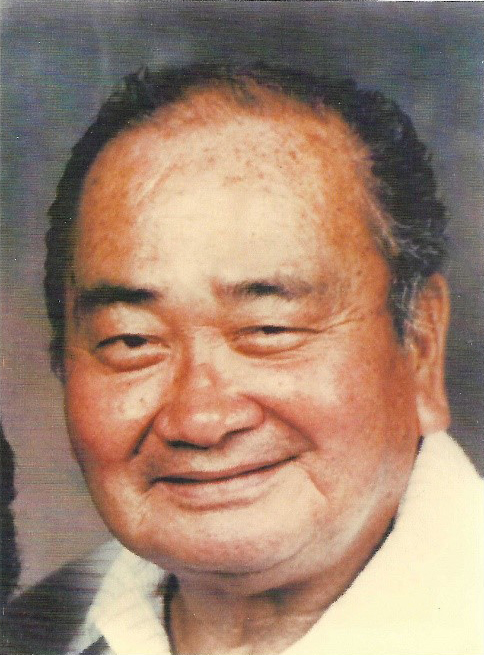
Sadao Hashimura
Private First Class
442nd Regimental Combat Team
3rd Battalion, I Company
Sadao Hashimura was born on October 25, 1921, in Wailuku, Maui, Territory of Hawaii. He was the eldest of five children born to Jinzo and Shikayo (Azeka) Hashimura. His siblings were: brothers Tsugio and Masami, and sisters Masae and Kameyo.
Jinzo emigrated from the village of Kasahara, Yame District, Fukuoka Prefecture, Japan, arriving on January 7, 1907, in Honolulu on the steamer S.S. Coptic. Shikayo emigrated from the village of Oki, Mii District, Fukuoka Prefecture, arriving on July 25, 1917, on the Persia Maru. They were married on June 29, 1920, in Puunene, Maui. Jinzo worked as a laborer for the Maui Agriculture Company. By 1920, he was working for the Pioneer Mill Company as a cultivation contractor. In 1930 and 1940, the family lived at Puukolii Camp in Lahaina. Sadao attended Puukolii School. In the 1940 Census, he was listed as “Masayoshi.”
Sadao, who was also known as “Mimi,” attended Puukolii Elementary and Intermediate Schools. In 1935, he participated in the Honolulu Star-Bulletin home-grown vegetable garden contest for inter-island schools.
He followed his father and worked for the Pioneer Mill Company, initially as a field laborer, and later as a cane loader operator. On December 14, 1940, he was awarded the “Most Outstanding Player” of a two-night/four-game invitational basketball tournament. Mimi, who played guard for Maui’s Midnight Inn team, scored eleven points. Although his team lost, he was presented the Coca-Cola Trophy by the Ewa Plantation Company and was described as a “stellar guard” The games were held at the Tenney Center in Honolulu.
Hashimura registered for the draft on February 14, 1942, at Local Board No. 2, Lahaina Courthouse, Lahaina, Maui. He lived with his family at Puukolii, near Lahaina. His point of contact was his brother Tsugio. He was 5’7” tall and weighed 150 pounds.
On March 23, 1943, Sadao enlisted in the Army. His civilian occupation was given as “Farm hand, crop specialty.” He had attended grammar school only. He was sent to the “tent city” known as Boom Town at Schofield Barracks with the other recruits. They were given a farewell aloha ceremony by the community on March 28 at Iolani Palace. On April 4, the new soldiers left on the S.S. Lurline for San Francisco enroute to Camp Shelby, Mississippi.
During training at Camp Shelby, Sadao was assigned to 3rd Battalion, I Company, 1st Platoon. His Army nickname was “Puukolii.”

I Co. First Platoon men at Camp Shelby; from left: Seikichi Ganeko, Shigera Hirano, Akira Wally Fukeda, Shusuke Fujitake, Koichi Furutani, Masao Furugen, Sadao Puukolii Hashimura (Ganeko and Fukeda were later killed in action.)
After over a year of basic and unit training, the 442nd left Camp Shelby for Camp Patrick Henry, Virginia, on April 22, 1944. They shipped out from nearby Hampton Roads to the Mediterranean Theater of Operations on May 2 in a large convoy of troop ships and arrived in Naples, Italy, on May 28. They then went by LSTs to the beachhead at Anzio. From Anzio, the 442nd transferred to a bivouac area near Civitavecchia, just north of Rome.
On June 26, 1944, the 442nd RCT moved forward from Civitavecchia to the front lines for their first combat engagement. I Company pushed off at 9:00 a.m. Two hours later they were stopped by fierce resistance from the Germans, unable to advance beyond Suvereto. This baptism of combat was followed by battlefield successes that made the 442nd RCT a legend.
Pfc. Sadao Hashimura was wounded on this first day of battle – June 26. He was treated and soon returned to his company.
Puukolii’s good buddy, Andy Yamashiro, later described the following action involving them on July 5 during the battle for Hill 140, just north of the Cecina River:
We were getting ready to ascend Hill 140. We were the leading squad of the lead platoon…Puukolii in front of me – always Puukolii in front, and I always behind him. ‘Hey! Puukolii, don’t look too good going up that hill in broad daylight!’ Halfway up the hill, they said we were on the reverse slope. The Germans knew we were there. Then it happened. I heard the hissing sound of a mortar shell: we caught a barrage. A slight hesitation, and we caught another one. Puukolii and I were huddled together in a small, shallow washout, clean with only pebbles.
Andy Yamashiro also commented that Puukolii was one of the largest men in the platoon and it was a miracle that he did not get wounded at Hill 140.

Pfc. Hashimura, from newspaper in 1944
Hashimura served throughout the 442nd’s time in Italy – Rome-Arno Campaign, then the two campaigns in France from October 1944 to March 1945 – Rhineland-Vosges and Rhineland-Maritime Alps Campaigns, and the return to Italy for the final campaign of the war – Po Valley Campaign.
For his military service, Private First Class Sadao Hashimura was awarded the Bronze Star Medal, Purple Heart Medal, Good Conduct Medal, American Campaign Medal, European-African-Middle Eastern Campaign Medal with four bronze stars, World War II Victory Medal, Army of Occupation Medal, Distinguished Unit Badge with one oak leaf cluster, Combat Infantryman Badge, and. He was awarded the Congressional Gold Medal on October 5, 2010, along with the other veterans of the 100th/442nd Regimental Combat Team. This is the highest Congressional Civilian Medal.
Hashimura arrived back in Hawaii on December 17, 1945, with 551 returning soldiers on the troop ship USAT Aconcagua. The ship left from San Francisco and docked at 8:00 a.m. at Pier 26. Hundreds of relatives and friends arrived early in the morning to get a glimpse of the soldiers, but most of them were disappointed. Soon after the men debarked, they were boarded onto Army trucks and were taken to Fort Kamehameha. There, they were processed, given passes, and told to return later for discharge. The Army announced that Fort Kamehameha was not restricted. Friends and relatives were welcome to visit the post and assistance given in locating soldiers there.

Hashimura married Florence Kiyoko Yamashita, the daughter of Hirokichi and Yoshiko (Morimoto) of Maui. They had one son and one daughter. He was active in Lahaina area activities and worked at the Pioneer Mill Company. He was Sergeant-at-Arms for the West Maui Athletic Association, worked with the West Maui AJA Veterans Club to build a gymnasium-auditorium for Lahaina, and was an active member of the 442nd Veterans Club’s Item Chapter (I Company) on Maui.
Hashimura in his later years
Sadao Hashimura died on April 18, 1989, in Lahaina. Survivors included his wife, two children, one grandchild, his mother, brother Tsugio, and sister Masae. He was inurned on April 21, 1989, at Maui Memorial Park, Garden of Meditation section. His wife Florence died on April 24, 2016, and was laid to rest next to him.
Researched and written by the Sons & Daughters of the 442nd Regimental Combat Team in 2021; updated in 2023.
